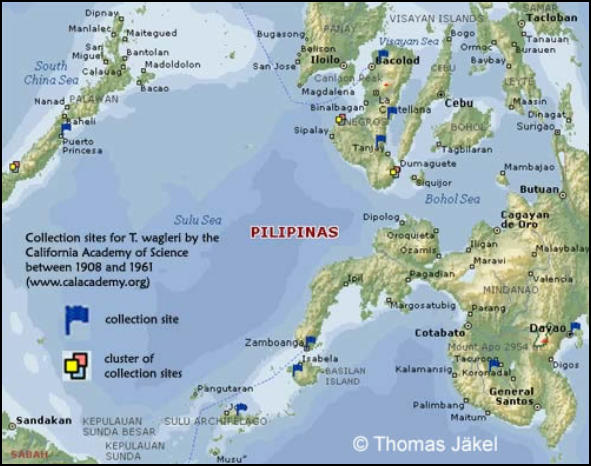

© 2004-2021 Thomas Jäkel

Geographic Variability
Previously, various geographically isolated populations in SE Asia were all subsumed under the single species, Tropidolaemus wagleri. Genetic evidence suggests, however, that the populations from peninsular Malaysia/Sumatra represent a different species compared to those from Borneo and Sulawesi (see taxonomy section). Therefore, Wagler’s vipers from Borneo and Sulawesi have been designated as T. subannulatus. Also with regard to phenotype, the two species show striking differences. This is what this chapter is about, see the images below. The genetic status of Philippine populations has not been determined yet. However, a new species, Tropidolaemus philippensis, has been decribed and other populations from northern as well as southern Philippines have been designated as T. subannulatus. Given the existence of thousands of islands in Southeast Asia, evolution of different species seems all too likely. I have tested the possibility to cross the Bornean with the Western Malaysian form, using a Borneo-male and Penang-female. Mating led to fertilized eggs and development of embryos. However, these died in an immature stage and were discharged by the female. I observed this two times, after two consecutive matings. Hence, there may exist a reproductive barrier between populations from Borneo and Western Malaysia. This is in line with the molecular data, but would require further investigation. Note that juvenile and adult males of different geographic origin are very similar (usually green or blueish green; no ontogenetic variation) in comparison to females, which undergo a significant change in body coloration from green as juveniles to a variety of colorations in adulthood (see 'How Females Change'). Adult males are much smaller than females, reaching only about 40-60 cm in comparison to the 70-100 cm of females. Fully-grown males from Western Malaysia and Sumatra usually exhibit characteristic red-white spots on the back, whereas adult Bornean males tend to show only white markings (however, they start with red-white as juveniles). Males from Sulawesi may show blue-white or red-white spots. Northern Philippine populations are unique as adult females also retain the juvenile pattern which is reflected in red-white bands contrasting with a fresh green. There is considerable confusion concerning animals from Borneo, Sulawesi and the Philippines, especially when they are juvenile. For instance, traders sometimes confuse Northern Philippine vipers with specimens from Sulawesi. Blue-banded juveniles from Borneo appear quite similar to specimens from Sulawesi, where adult females usually show a more or less prominent blue banding pattern. Please, check the 'Images' section to get a better idea of geographical variation.Distribution in the
Philippines
Stunning images from blue and orange specimens from the Southern Philippines (Mindanao, Negros etc.) have been published recently, including new species designations (Vogel 2006). The Philippines are certainly a hot spot in Wagleri evolution. However, a thorough scientific revision of the Wagleri-complex has not been published yet, and further genetic analysis is overdue. Leviton (1964) reported T. wagleri to occur on Luzon, Negros, Samar, Leyte, Mindanao, Basilan, Jolo, Palawan and Balabac. The map below depicts some collection sites in the Philippines for T. wagleri (currently T. subannulatus) deposited in the California Academy of Sciences Collection. This collection was made between the years 1908 and 1961, whereby the majority of specimen were found on Negros, Mindanao and Palawan. Tropidolaemus philippensis (Gray, 1842) is currently known only from southern and western parts of the island of Mindanao.


- Home
- Wagler's Viper Site (WVS)
- General Husbandry - WVS
- Breeding - WVS
- Health Problems - WVS
- Taxonomy and Phylogenetics - WVS
- Biology - WVS
- Geographic Variability - WVS
- How Females Change - WVS
- Venom - WVS
- Image Map - WVS
- Special: T. laticinctus - WVS
- Special: North Sumatra - WVS
- Special: Video on Mating - WVS
- Special: North Sulawesi - VVS
- Biological Rodent Control - BRC
- Rodent Management Laos - BRC
- Gallery
- Contact















